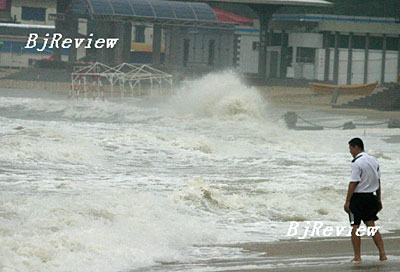|

In the past 30 years, China's overall sea level has risen 90 mm with the average offshore surface temperature increasing by 0.9 degrees centigrade, warned the recently released 2007 Sea-level Monitoring Report by China's State Oceanic Administration (SOA).
While the global sea level rose 1.7 mm every year between 1975 and 2007, the Chinese sea level rose 2.5 mm each year, the SOA report said.
Two key cities, Shanghai and Tianjin, are among those facing the biggest threat, SOA Spokesman Li Haiqing said, citing the agency's latest report.
The report showed that in the last 30 years, China's financial hub Shanghai has seen the sea level rise 115 mm, the length of half a chopstick. While Tianjin, a major port close to the capital Beijing, has seen the level rise as much as 196 mm, about the length of a new pencil.
Liaoning, Shandong and Zhejiang provinces saw sea levels rise about 100 mm, while in Fujian and Guangdong provinces, including the area around the Pearl River Delta and Hong Kong, the rise was 50-60 mm.
In the report, the SOA also forecast that China's coastal sea level is likely to rise by 32 mm every year in the next decade.
Coastal economy threatened
The 2007 sea-level monitoring report was the first time the SOA has reported the cumulative figures of sea level rises in the last 30 years. The report, which used to be released every three years, is now being released annually.
Global warming is the main reason for the rising sea levels, SOA officials said, but surface subsidence is also to blame for the threat of floods in Shanghai and Tianjin--due to their "indiscriminate exploitation of groundwater resources," said Chen Manchun, a researcher with the SOA.
The sea level rise will result in an increasing frequency and intensity of coastal weather disasters. Meanwhile the shoreline will be forced to retreat and islands are shrinking as the sea level rises, said another SOA expert Zheng Shuying.
Statistics showed that China had 67 storm tides between 2001 and 2005, doubling the number of that between 1996 and 2000 and resulting in a direct economic loss of 61 billion yuan ($8.3 billion).
Coastal erosion is the second serious impact on the coastal areas due to rising sea levels. According to the monitoring results on the country's key coasts, the speed of erosion is accelerating, the SOA found.
Artificial coastlines have been built in places to take the place of natural ones diminishing the impact of sea erosion, said Zheng.
| 